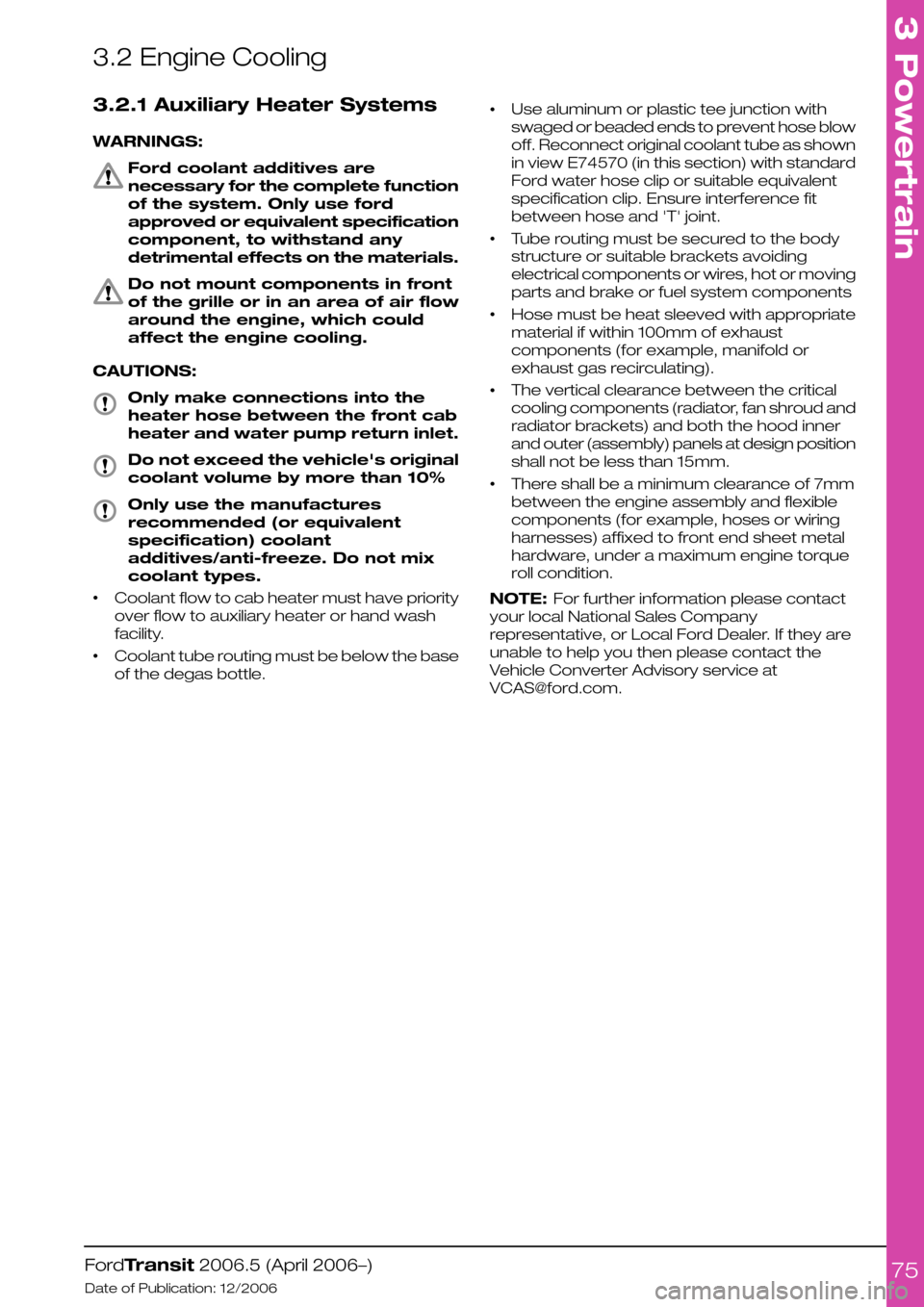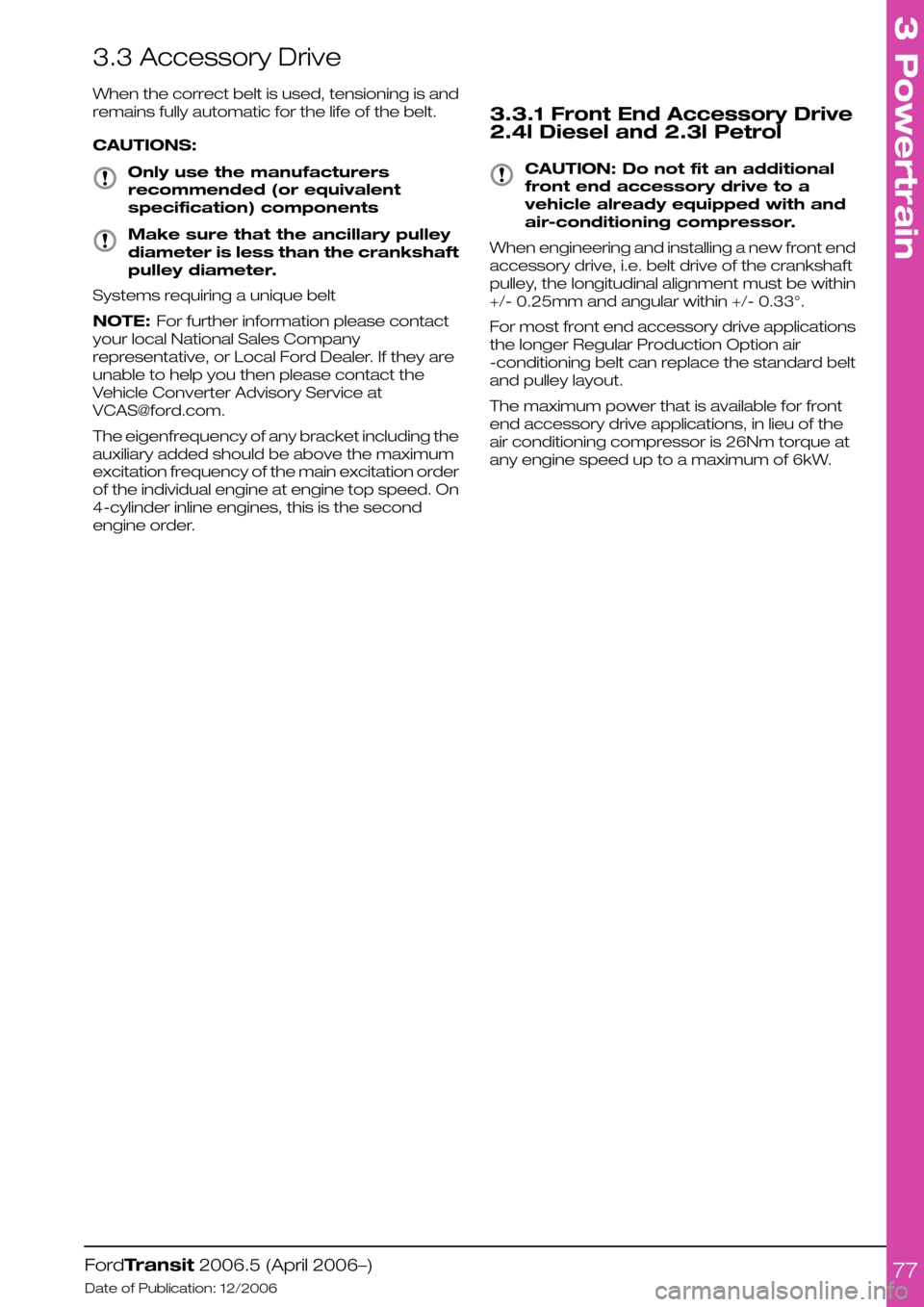Page 62 of 234

2.6 Brake System
2.6.1 General
The Brake System must be fully functional when
the vehicle conversion is completed. The vehicle
brake operating modes must be checked,
including warning system and parking brakes.
Brakes are certified to 71/320EEC and ECE R13
requirements as amended.
WARNING: Do not restrict the airflow
and cooling to the brake system
CAUTION: Spoilers and wheel covers
must not affect the brake cooling
performance.
NOTE: Do not obstruct the view of the brake
fluid reservoir level
NOTE: The donor vehicle brake fluid reservoir is
translucent so that it is possible to check the level
of fluid without opening the reservoir which will
reduce the risk of contamination.
The brake fluid reservoir must remain accessible
for servicing and for adding brake fluid.
2.6.2 Kerb Mass Data
NOTE: For further information please contact
your local National Sales Company representative,
or Local Ford Dealer. If they are unable to help
you then please contact the Vehicle Converter
Advisory Service at [email protected].
2.6.3 Brake Hoses General
CAUTION: Make sure that the front
and rear brake hoses are not
twisted and are correctly located
away from body and chassis
components.
Front and rear brake hoses must not rub, chafe
or rest on body or chassis components. There
must be clearance under all operating conditions,
between full compression and extension and full
lock to lock.
Brake lines must not be used to support or
secure any other component.
FordTransit 2006.5 (April 2006–)
Date of Publication: 12/2006
2 Chassis
62
Page 63 of 234
2.7 Parking Brake
WARNINGS:
Do not modify the brakes
Do not splice into the parking brake
cable
CAUTION: Make sure that a new
parking brake cable is fitted if
modification to the wheelbase
impacts the existing parking brake
cable.
2.7.1 Relocated Parking Brake
Lever
For improved walk through capability it is
recommended to have the standard handbrake
moved to the outer side between the driver door
and the driver seat. If the handbrake is moved
the wiring will need to be modified/extended to
accommodate this.
NOTE: For further information please contact
your local National Sales Company
representative, or Local Ford Dealer. If they are
unable to help you then please contact the
Vehicle Converter Advisory Service at
[email protected]..
Recommended Relocated Parking Brake Lever location
FordTransit 2006.5 (April 2006–)
Date of Publication: 12/2006
2 Chassis
63E76770
Page 64 of 234
2.8 Hydraulic Brake Actuation
2.8.1 Load Apportioning Valves
•It is not necessary or recommended to modify
the load apportioning valves, however, if a
special conversion should require modifications
–Maintain original settings
–Maintain brake certification load distribution
NOTE: For further information please contact
your local National Sales Company representative,
or Local Ford Dealer. If they are unable to help
you then please contact the Vehicle Converter
Advisory Service at [email protected].
2.8.2 Front and Rear Brakes
WARNINGS:
Do not modify the brakes
Do not modify the disc in flow and
out flow of cooling air
FordTransit 2006.5 (April 2006–)
Date of Publication: 12/2006
2 Chassis
64
Page 65 of 234
2.9 Anti-Lock Control - Stability Assist
WARNING: Do not modify any part
of the braking system, including Anti
Brake System (ABS), Traction
Control System (TCS) and
Interactive Vehicle Dynamics
(IVD)System.
NOTE: For further information please contact
your local National Sales Company
representative, or Local Ford Dealer. If they are
unable to help you then please contact the
Vehicle Converter Advisory Service at
[email protected].
FordTransit 2006.5 (April 2006–)
Date of Publication: 12/2006
2 Chassis
65
Page 75 of 234

3.2 Engine Cooling
3.2.1 Auxiliary Heater Systems
WARNINGS:
Ford coolant additives are
necessary for the complete function
of the system. Only use ford
approved or equivalent specification
component, to withstand any
detrimental effects on the materials.
Do not mount components in front
of the grille or in an area of air flow
around the engine, which could
affect the engine cooling.
CAUTIONS:
Only make connections into the
heater hose between the front cab
heater and water pump return inlet.
Do not exceed the vehicle's original
coolant volume by more than 10%
Only use the manufactures
recommended (or equivalent
specification) coolant
additives/anti-freeze. Do not mix
coolant types.
•Coolant flow to cab heater must have priority
over flow to auxiliary heater or hand wash
facility.
•Coolant tube routing must be below the base
of the degas bottle.
•Use aluminum or plastic tee junction with
swaged or beaded ends to prevent hose blow
off. Reconnect original coolant tube as shown
in view E74570 (in this section) with standard
Ford water hose clip or suitable equivalent
specification clip. Ensure interference fit
between hose and 'T' joint.
•Tube routing must be secured to the body
structure or suitable brackets avoiding
electrical components or wires, hot or moving
parts and brake or fuel system components
•Hose must be heat sleeved with appropriate
material if within 100mm of exhaust
components (for example, manifold or
exhaust gas recirculating).
•The vertical clearance between the critical
cooling components (radiator, fan shroud and
radiator brackets) and both the hood inner
and outer (assembly) panels at design position
shall not be less than 15mm.
•There shall be a minimum clearance of 7mm
between the engine assembly and flexible
components (for example, hoses or wiring
harnesses) affixed to front end sheet metal
hardware, under a maximum engine torque
roll condition.
NOTE: For further information please contact
your local National Sales Company
representative, or Local Ford Dealer. If they are
unable to help you then please contact the
Vehicle Converter Advisory service at
[email protected].
FordTransit 2006.5 (April 2006–)
Date of Publication: 12/2006
3 Powertrain
75
Page 76 of 234

Water Hoses for Auxiliary Heating System
DescriptionItem
Connector (aluminum or plastic)1
Heater hose - maintain heater fluid2
Original flow3
To ancillary equipment4
3.2.2 Auxiliary Heater Installation
For an auxiliary heating system it must be ensured
that the exhaust gas of such a system cannot be
re-circulated into the vehicle. The exhaust gases
must not pass into the engine intake system or
the air intake for the passenger compartment
ventilation. The heating system should be installed
outside the passenger compartment. The
location of the heating system should not be in
close proximity to movable components. Any
body reworks which damage the paint must be
fully protected against corrosion.
Refer to: 5.10 Corrosion Prevention (page 221).
NOTE: The installation must be in line with the
appropriate legal requirements
3.2.3 Air Flow Restrictions
WARNING: Do not mount
components in front of the grille or
in an area of air flow around the
engine, which could affect the
engine cooling performance.
CAUTION: Over heating within the
engine compartment can seriously
compromise component robustness.
NOTE: For further information please contact
your local National Sales Company representative,
or Local Ford Dealer. If they are unable to help
you then please contact the Vehicle Converter
Advisory Service at [email protected].
FordTransit 2006.5 (April 2006–)
Date of Publication: 12/2006
3 Powertrain
76E745701234
Page 77 of 234

3.3 Accessory Drive
When the correct belt is used, tensioning is and
remains fully automatic for the life of the belt.
CAUTIONS:
Only use the manufacturers
recommended (or equivalent
specification) components
Make sure that the ancillary pulley
diameter is less than the crankshaft
pulley diameter.
Systems requiring a unique belt
NOTE: For further information please contact
your local National Sales Company
representative, or Local Ford Dealer. If they are
unable to help you then please contact the
Vehicle Converter Advisory Service at
[email protected].
The eigenfrequency of any bracket including the
auxiliary added should be above the maximum
excitation frequency of the main excitation order
of the individual engine at engine top speed. On
4-cylinder inline engines, this is the second
engine order.
3.3.1 Front End Accessory Drive
2.4l Diesel and 2.3l Petrol
CAUTION: Do not fit an additional
front end accessory drive to a
vehicle already equipped with and
air-conditioning compressor.
When engineering and installing a new front end
accessory drive, i.e. belt drive of the crankshaft
pulley, the longitudinal alignment must be within
+/- 0.25mm and angular within +/- 0.33°.
For most front end accessory drive applications
the longer Regular Production Option air
-conditioning belt can replace the standard belt
and pulley layout.
The maximum power that is available for front
end accessory drive applications, in lieu of the
air conditioning compressor is 26Nm torque at
any engine speed up to a maximum of 6kW.
FordTransit 2006.5 (April 2006–)
Date of Publication: 12/2006
3 Powertrain
77
Page 82 of 234
3.5 Clutch
The manufacturer does not offer the option of a
reinforced clutch system. The axle ratio available
is dependent on the weight of the specified donor
vehicle.
It is necessary to select the appropriate drive,
engine, gear ratio, gross vehicle mass, gross train
mass, axle plates and payloads of the base
vehicle to match the customers order.
Where possible make sure that the base vehicle
is ordered with plant fit options
NOTE: For further information please contact
your local National Sales Company representative,
or Local Ford Dealer. If they are unable to help
you then please contact the Vehicle Converter
Advisory Service at [email protected].
FordTransit 2006.5 (April 2006–)
Date of Publication: 12/2006
3 Powertrain
82